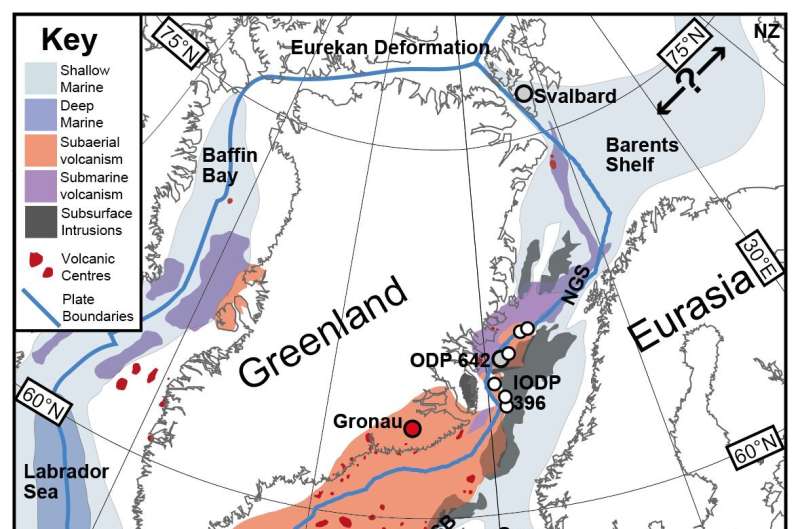North Atlantic volcanic activity was a major driver of climate change 56 million years ago, study finds

The Paleocene–Eocene Thermal Maximum (PETM) is a period of global warming that occurred ~56 million years ago, lasting approximately 200,000 years, when the Earth experienced global surface temperature elevations of ~5°C.
Hypotheses for the cause of this hyperthermal (short-lived warming) event have included destabilization of methane hydrates (ice-like solids of methane and water) due to orbital forcing (changes in incoming solar radiation due to variation in the tilt of the Earth's axis and orbit) and uplift of the land causing weathering of marine rocks.
However, new research in Climate of the Past has suggested that volcanic activity within the North Atlantic contributed significant amounts of greenhouse gases to the atmosphere (it was active 63–54 million years ago but experienced peak volcanism 56–54 million years ago). Increased carbon emissions fall in line with a prominent spike in lighter carbon (12C) recorded in the shells of fossil microorganisms living in the oceans at the time, foraminifera. It enhances the greenhouse effect by trapping and absorbing heat radiating from the Earth's surface, causing a positive feedback loop of ever-increasing temperatures.
This volcanism spans a vast North Atlantic Igneous Province (NAIP) located between Greenland, north of the United Kingdom and west of Norway, with the total volume of magma thought to have been emplaced up to 1,000,000 km3, equating to a carbon reservoir of 35,000 gigatons.
To determine the contribution of the NAIP on PETM climate change, Dr. Morgan Jones from the University of Oslo and colleagues, turned to the sediment record preserved on the island of Fur, Denmark, where a complete section preceding the PETM through to after the event is present, having been uplifted from the seafloor over millennia.
Here, hundreds of ash layers (>1cm thick) derived from the NAIP can be found, which the scientists analyzed for particular elements to determine volcanic activity, changes in hydrology regimes and weathering. Such measurements are termed proxies, and provide an indication of past environmental conditions when direct measurements aren't available, unlike today when we can use instruments to measure emissions in real time.

Volcanic proxies include mercury and osmium that are released during eruptions and are deposited with organic matter. Their progressive enrichment through the succession indicates elevated NAIP activity leading up to the PETM, before a fairly prompt decline during the recovery phase post-event. This would have been comprised of basaltic eruptions and thermogenic degassing (removal of dissolved gases from liquids) due to contact with magma intrusions.
In the latter case, high levels of methane contributed significantly to global warming as it is a powerful greenhouse gas, 28 times more potent than carbon dioxide at trapping heat over a 100-year period. Dr. Jones suggests a distinct change in the activity of the NAIP from effusive (outpouring of lava onto the ground) to explosive (including ash clouds and volcanic bombs, for example) over this period.
Paleoclimate proxies include carbon, lithium and osmium, the latter two being tracers of silicate weathering. Lithium and osmium abundances increase during the peak and then post-PETM, highlighting enhanced silicate weathering and erosion resulting from a more intense hydrological cycle due to global warming. However, lithium measurements do not correspond fully to the palaeotemperature of the time, with Dr. Jones and colleagues suggesting that uplift of the NAIP would have contributed to providing more exposed rock for weathering and erosion to take place.
Post-PETM weathering of the silica-rich basaltic lava flows used carbon dioxide from the atmosphere to form carbonate and bicarbonate compounds that would sequester this greenhouse gas into the rock, helping to draw down carbon dioxide and therefore aid recovery from the climatic event. In addition, an enhanced hydrological cycle transported ash to the sea for burial, which would have helped create a negative feedback loop whereby more carbon was removed from the atmosphere and hydrosphere; thus, the greenhouse forcing reduced and global temperatures declined.
It is worth noting that not all of the volcanic record is preserved here, as only the most explosive eruptions would have had ash reach from the North Atlantic to Denmark to be preserved and discovered by scientists millions of years later. While there is still much more work to be conducted on climate change events over geological timescales, they are important to study as they offer a window into future global warming, understanding how both natural and anthropogenic-induced carbon dioxide will impact our world.
More information: Morgan T. Jones et al, Tracing North Atlantic volcanism and seaway connectivity across the Paleocene–Eocene Thermal Maximum (PETM), Climate of the Past (2023). DOI: 10.5194/cp-19-1623-2023.
Journal information: Climate of the Past
© 2023 Science X Network
Carbon emissions from volcanic rocks can create global warming: study
No comments:
Post a Comment